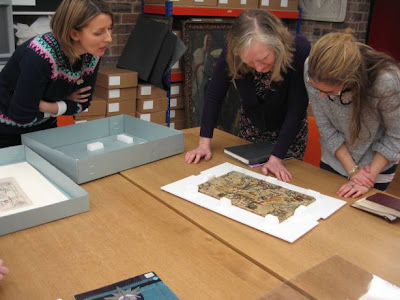Saturday, 4 May 2013
Glasgow School of Art & The Needlework Development Scheme
The Needlework Development Scheme was a collaborative project between art and design education and industry. Originally established in Scotland in 1934, its aim was to encourage embroidery and to raise the standard of design in Britain. Financed by J and P Coates, the thread manufacturers, the Scheme was organised by the four Scottish art schools, Aberdeen, Dundee, Edinburgh and Glasgow. Its collection of foreign and British embroidery was available to domestic science and training colleges, women's institutions and schools, as well as art schools. By 1939, the Scheme had acquired some 900 embroideries but the outbreak of WWII closed the Scheme and the collection was retained by the four original art schools. An example is this stunning stumpwork panel.
The date is worked in small mica beads.
The range of embroideries in Glasgow School of Art Archives is quite wide as you can see from the samples here. Glasgow School of Art was instrumental in re-starting the Scheme late in 1944. Its aims were the same as its predecessor, but expanded its remit to include other arts schools in the United Kingdom where embroidery was taught. In the years following the WWII, the Scheme became centralised and staffed with a qualified embroidery expert, a secretary and several practitioners. The Scheme commissioned the British designer Mary Kessell to prepare designs to be interpreted by embroidery artists in Britain, as the best needlework examples in the collection were foreign.
The scheme was disbanded in 1961 when funding was withdrawn, although it was recognised that the NDS had achieved its aims. The NDS had amassed 3000 textile items by this time, which were divided and distributed around universities, organisations and museums including Glasgow School of Art, National Museum of Scotland, the Embroiderers’ Guild and the Victoria & Albert.
You can see more examples in the Glasgow School of Art Needlework Development Scheme Archives by clicking here.
Subscribe to:
Post Comments (Atom)








No comments:
Post a Comment